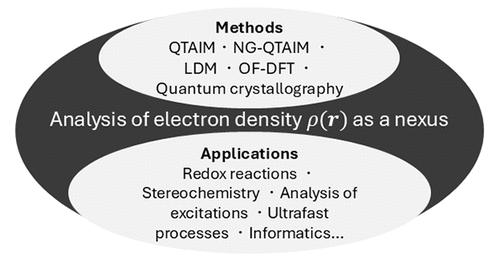当前位置:
X-MOL 学术
›
Chem. Rev.
›
论文详情
Our official English website, www.x-mol.net, welcomes your
feedback! (Note: you will need to create a separate account there.)
The Analysis of Electron Densities: From Basics to Emergent Applications
Chemical Reviews ( IF 51.4 ) Pub Date : 2024-11-15 , DOI: 10.1021/acs.chemrev.4c00297 Daniel Koch, Michele Pavanello, Xuecheng Shao, Manabu Ihara, Paul W. Ayers, Chérif F. Matta, Samantha Jenkins, Sergei Manzhos
Chemical Reviews ( IF 51.4 ) Pub Date : 2024-11-15 , DOI: 10.1021/acs.chemrev.4c00297 Daniel Koch, Michele Pavanello, Xuecheng Shao, Manabu Ihara, Paul W. Ayers, Chérif F. Matta, Samantha Jenkins, Sergei Manzhos

|
The electron density determines all properties of a system of nuclei and electrons. It is both computable and observable. Its topology allows gaining insight into the mechanisms of bonding and other phenomena in a way that is complementary to and beyond that available from the molecular orbital picture and the formal oxidation state (FOS) formalism. The ability to derive mechanistic insight from electron density is also important with methods where orbitals are not available, such as orbital-free density functional theory (OF-DFT). While density topology-based analyses such as QTAIM (quantum theory of atoms-in-molecules) have been widely used, novel, vector-based techniques recently emerged such as next-generation (NG) QTAIM. Density-dependent quantities are also actively used in machine learning (ML)-based methods, in particular, for ML DFT functional development, including machine-learnt kinetic energy functionals. We review QTAIM and its recent extensions such as NG-QTAIM and localization-delocalization matrices (LDM) and their uses in the analysis of bonding, conformations, mechanisms of redox reactions excitations, as well as ultrafast phenomena. We review recent research showing that direct density analysis can circumvent certain pitfalls of the FOS formalism, in particular in the description of anionic redox, and of the widely used (spherically) projected density of states analysis. We discuss uses of density-based quantities for the construction of DFT functionals and prospects of applications of analyses of density topology to get mechanistic insight with OF-DFT and recently developed time-dependent OF-DFT.
中文翻译:

电子密度分析:从基础到新兴应用
电子密度决定了原子核和电子系统的所有性质。它既是可计算的,也是可观察的。它的拓扑结构允许以一种与分子轨道图片和形式氧化态 (FOS) 形式互补并超越其方式来深入了解键合机制和其他现象。对于没有轨道的方法,例如无轨道密度泛函理论 (OF-DFT),从电子密度中获得机理见解的能力也很重要。虽然基于密度拓扑的分析(如 QTAIM (分子原子的量子理论))已被广泛使用,但最近出现了基于矢量的新型技术,例如下一代 (NG) QTAIM。密度相关量也积极用于基于机器学习 (ML) 的方法,特别是用于 ML DFT 函数开发,包括机器学习的动能函数。我们回顾了 QTAIM 及其最近的扩展,例如 NG-QTAIM 和定位离域矩阵 (LDM) 及其在分析键合、构象、氧化还原反应激发机制以及超快现象中的应用。我们回顾了最近的研究表明,直接密度分析可以规避 FOS 形式主义的某些陷阱,特别是在阴离子氧化还原的描述和广泛使用的(球形)投影状态密度分析方面。我们讨论了基于密度的量在 DFT 泛函构建中的应用以及密度拓扑分析的应用前景,以获得 OF-DFT 和最近开发的瞬态 OF-DFT 的机理见解。
更新日期:2024-11-15
中文翻译:

电子密度分析:从基础到新兴应用
电子密度决定了原子核和电子系统的所有性质。它既是可计算的,也是可观察的。它的拓扑结构允许以一种与分子轨道图片和形式氧化态 (FOS) 形式互补并超越其方式来深入了解键合机制和其他现象。对于没有轨道的方法,例如无轨道密度泛函理论 (OF-DFT),从电子密度中获得机理见解的能力也很重要。虽然基于密度拓扑的分析(如 QTAIM (分子原子的量子理论))已被广泛使用,但最近出现了基于矢量的新型技术,例如下一代 (NG) QTAIM。密度相关量也积极用于基于机器学习 (ML) 的方法,特别是用于 ML DFT 函数开发,包括机器学习的动能函数。我们回顾了 QTAIM 及其最近的扩展,例如 NG-QTAIM 和定位离域矩阵 (LDM) 及其在分析键合、构象、氧化还原反应激发机制以及超快现象中的应用。我们回顾了最近的研究表明,直接密度分析可以规避 FOS 形式主义的某些陷阱,特别是在阴离子氧化还原的描述和广泛使用的(球形)投影状态密度分析方面。我们讨论了基于密度的量在 DFT 泛函构建中的应用以及密度拓扑分析的应用前景,以获得 OF-DFT 和最近开发的瞬态 OF-DFT 的机理见解。

































 京公网安备 11010802027423号
京公网安备 11010802027423号